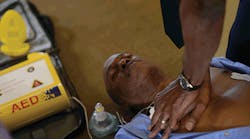Over the years there has been a conscious effort to install automated external defibrillators (AED) units in more and more locations. The great news about AEDs is the cost is coming down and a lot of companies and most municipalities are purchasing them.
Although OSHA does not require companies to purchase AEDs, they do suggest that each workplace evaluate its own requirements for an AED as part of its first-aid program. Because of the lower cost, proven technology and ease of use, AEDs should be considered for all worksites due to the possibility of sudden cardiac arrest (SCA) and the need for timely defibrillation.
Using AEDs as soon as possible after SCA, within three to four minutes, can lead to a 60 percent survival rate according to the American Heart Association (AHA). OSHA has stated that simply waiting until the arrival of emergency medical service (EMS) personnel drops the chance of survival to between 5 to 7 percent.
AHA Chain of Survival
Everyone loves to read about the case studies of successful outcomes where a victim of SCA was saved because volunteer emergency responders reacted appropriately during a "man down" situation. Quickly accessing the medical condition of the victim and enacting AHA's chain of survival increases the chance of survival. The five links in the AHA adult chain of survival are:
- Immediate recognition of cardiac arrest and activation of the emergency response system.
- Early cardiopulmonary resuscitation (CPR) with an emphasis on chest compressions.
- Rapid defibrillation.
- Effective advanced life support.
- Integrated post-cardiac arrest care.
There is a lot more responsibility to owning an AED than simply installing the unit in a cabinet on the wall with a sign mounted above it indicating that a powerful lifesaving piece of equipment permanently resides here.
Often, volunteers have compelted the necessary initial training on first aid, bloodborne pathogens, CPR and how to operate AEDs, but that is where their AED program stopped. There was no follow-up, and no one checked to ensure the AED on the wall was functioning properly.
Acting in this manner would be like playing Russian roulette, essentially banking that there will not be a SCA event at your facility. There are media reports of tragic situations where individuals stricken with SCA did not survive due to an AED, or multiple AEDs, malfunctioning. This is not how you want an organization to make news, by not having a rescue-ready AED unit due to improper maintance or poor battery management, and by not offering refresher training for emergency responders on a timely basis.
An effective AED training program is a critical component of an overall company AED program. Five main areas of the AED training program include:
Having a written training plan – Developing a written training plan that outlines what material will be covered, how often the AED training/retraining classes are conducted and who will conduct the training are important for the long-term health of the program.
Initial and refresher training – Initial training for the volunteer emergency responders should cover CPR, basic first aid and bloodborne pathogens.
Depending on the complexity of your program and based on the number of locations and emergency responders, instructor-led classroom training or online self-paced training could be appropriate. The hands on portion of the CPR and AED training should be instructor-led. If you plan on using an outside training company for remote locations, be aware they will probably have minimum class size restrictions.
In a conversation with Kent Shea, who works for the Janesville (Wisconsin) Fire Department as a lieutenant/paramedic and is co-owner and president of CPR-First LLC, we discussed how his company prepares emergency responders by simulating training that avoids the sense of complacency that comes with classroom-only instruction.
For recertification of emergency responders who have been through the training already, instructors have been doing more scenario-based training. Shea said, "We will put a dummy in a certain situation and then have a response team find them or get called to a certain part of the facility and have the emergency responders initiate the assessment and treatment."
The scenario transpires under the watchful eye of the instructor. This type of training helps prepare them for a real world situation and they learn from mistakes before they really happen.
All training and recertification records must be documented. The old adage of "if it's not documented, it didn't happen" applies here.
Shea went on to say that he feels that the AHA's initiatives in training middle school-aged children as early as sixth grade will help improve the survival rate of SCA victims for future generations.
Debriefing – After each mock training session, it is important that the emergency responders and instructors reconvene to discuss how the scenario played out. They should discuss what went well and where improvements can be made to provide a more effective emergency response.
Backup plan – An issue AED program managers identify as an area of concern is finding enough volunteers who want to go through the AED training to cover all locations and each shift. In some instances, where there are not enough volunteers, companies may not deploy an AED. Soliciting enough volunteers to create a bullpen of potential team members is critical to the success of the program.
Having backup consumables such as replacement batteries and electrode pads is an insurance policy in case something goes wrong with the originals.
Another aspect of the backup plan that often is overlooked is the steps that need to be initiated if there is a SCA event and the AED was deployed. As the patient is being transported to the hospital, it is imperative that the AED be readied for the next response. Items that need to be replaced could include battery packs, electrode pads and other kit supplies including disposable gloves and razors that were used in treating the patient.
Keeping the plan current – Whether you have one or 400 AEDs, keeping your AED training program up to date is a must. This especially is important when you have AEDs at multiple facilities and you simply cannot visually inspect all the units yourself. It is important to know the condition of your units and to stay updated on the availability of your AED site caretakers.
There have been situations where a company was informed by their AED maintenance service provider that the required monthly report was overdue.
Upon further investigation it was discovered that the onsite AED coordinator had left the company. Without timely notification of the delinquent inspection, it's possible an SCA event could have occurred and the AED units at that facility might not have been operational for some reason.
Keeping on top of the recertification dates of all the voluntary emergency responders is crucial to prevent lapses in their first aid and CPR certifications. Calendar reminders 60 and 30 days out can be set before expiration due dates. Subscription-based services manage that responsibility and will update you on the status of your team members impending recertification dates.
It is important to remember that ongoing monitoring of your training program and the maintenance of the AEDs at your facility is critical to the success of the program. It is imperative that EHS professionals breathe new life into their AED, first aid and CPR training programs.
The time to find deficiencies in your program is NOT during a SCA event.
Having a rescue-ready AED available at the scene doesn't ensure that a victim in cardiac arrest will survive, but it gives them a fighting chance.

